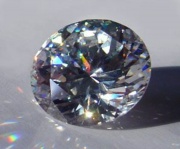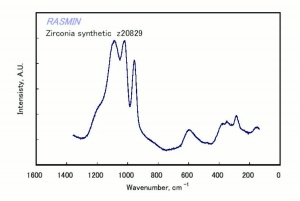Difference between revisions of "Zirconium oxide"
Jump to navigation
Jump to search
(username removed) |
|||
| (3 intermediate revisions by 2 users not shown) | |||
| Line 2: | Line 2: | ||
== Description == | == Description == | ||
| − | Hard, dense, white powder that occurs in nature as the mineral [ | + | Hard, dense, white powder that occurs in nature as the mineral [[baddeleyite|baddeleyite]]. Synthetic zirconia is used for high temperature insulation and [[abrasive|abrasives]]. It has also been used as a paint [[pigment|pigment]], an [[opacifier|opacifier]], and as a colorant to make [[white%20glass|white glass]]. |
== Synonyms and Related Terms == | == Synonyms and Related Terms == | ||
| Line 10: | Line 10: | ||
[[[SliderGallery rightalign|zirconiasynRS.jpg~Raman|zirconium oxide.jpg~Chemical structure]]] | [[[SliderGallery rightalign|zirconiasynRS.jpg~Raman|zirconium oxide.jpg~Chemical structure]]] | ||
| − | == | + | == Risks == |
| + | |||
| + | * Fisher Scientific: [https://fscimage.fishersci.com/msds/96644.htm MSDS] | ||
| + | |||
| + | == Physical and Chemical Properties == | ||
Slightly soluble in acids. Insoluble in water. | Slightly soluble in acids. Insoluble in water. | ||
| Line 23: | Line 27: | ||
|- | |- | ||
! scope="row"| Melting Point | ! scope="row"| Melting Point | ||
| − | | 2680 | + | | 2680 C |
|- | |- | ||
! scope="row"| Density | ! scope="row"| Density | ||
| − | | 5.85 | + | | 5.85 g/ml |
|- | |- | ||
! scope="row"| Molecular Weight | ! scope="row"| Molecular Weight | ||
| Line 32: | Line 36: | ||
|- | |- | ||
! scope="row"| Boiling Point | ! scope="row"| Boiling Point | ||
| − | | 4300 | + | | 4300 C |
|} | |} | ||
| − | |||
| − | |||
| − | |||
| − | |||
== Comparisons == | == Comparisons == | ||
| − | [[media: | + | [[media:download_file_209.pdf|Properties of Common Abrasives]] |
| − | |||
| − | |||
| − | == | + | ==Resources and Citations== |
* ''The Merck Index'', Susan Budavari (ed.), Merck Research Labs, Whitehouse Station, NJ, 12th Edition, 1996 Comment: entry 9985 | * ''The Merck Index'', Susan Budavari (ed.), Merck Research Labs, Whitehouse Station, NJ, 12th Edition, 1996 Comment: entry 9985 | ||
| Line 51: | Line 49: | ||
* Art and Architecture Thesaurus Online, http://www.getty.edu/research/tools/vocabulary/aat/, J. Paul Getty Trust, Los Angeles, 2000 | * Art and Architecture Thesaurus Online, http://www.getty.edu/research/tools/vocabulary/aat/, J. Paul Getty Trust, Los Angeles, 2000 | ||
| − | * Wikipedia | + | * Wikipedia: http://en.wikipedia.org/wiki/Zirconia (Accessed Nov. 29, 2005) |
[[Category:Materials database]] | [[Category:Materials database]] | ||
Latest revision as of 12:15, 2 June 2022
Description
Hard, dense, white powder that occurs in nature as the mineral Baddeleyite. Synthetic zirconia is used for high temperature insulation and abrasives. It has also been used as a paint Pigment, an Opacifier, and as a colorant to make White glass.
Synonyms and Related Terms
zirconia; zirconium dioxide, zirconium (IV) oxide; zircone (Fr.); oxyde de zirconium (Fr.); Zirkoniumdioxid (Deut.); Zirkonoxid (Deut.); oxeidio toy zirkonioy (Gr.); ossido di zirconio (It.); zirkoonoxide (Ned.); óxido de zircónio (Port.); zirconic anhydride; baddeleyite;
Risks
- Fisher Scientific: MSDS
Physical and Chemical Properties
Slightly soluble in acids. Insoluble in water.
| Composition | ZrO2 |
|---|---|
| CAS | 1314-23-4 |
| Melting Point | 2680 C |
| Density | 5.85 g/ml |
| Molecular Weight | mol. wt. = 123.22 |
| Boiling Point | 4300 C |
Comparisons
Properties of Common Abrasives
Resources and Citations
- The Merck Index, Susan Budavari (ed.), Merck Research Labs, Whitehouse Station, NJ, 12th Edition, 1996 Comment: entry 9985
- Art and Architecture Thesaurus Online, http://www.getty.edu/research/tools/vocabulary/aat/, J. Paul Getty Trust, Los Angeles, 2000
- Wikipedia: http://en.wikipedia.org/wiki/Zirconia (Accessed Nov. 29, 2005)

